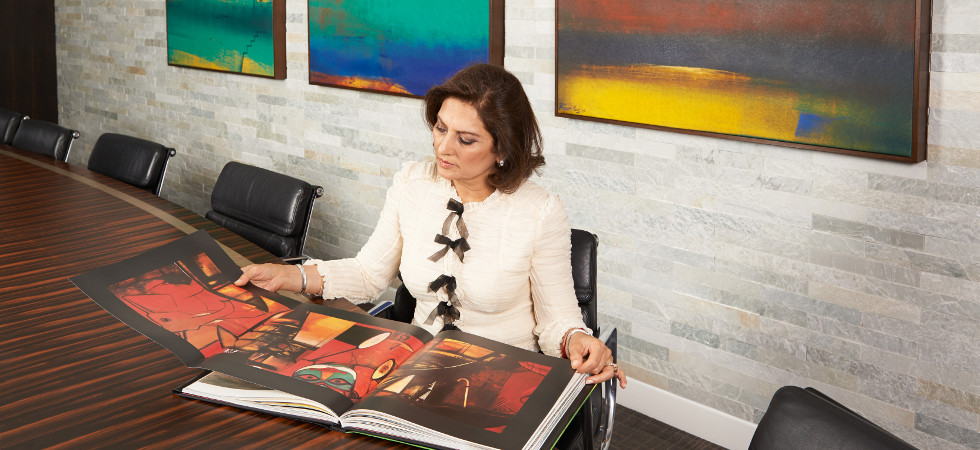Mrs Anita Choudhrie is the matriarch of one of India’s most eminent and wealthy UK-based families. The family presides over a global business empire spanning hotels, healthcare and aviation.
Today, Mrs Choudhrie channels her energies into philanthropy, and set up Path to Success in 2005, a charity focused on ‘turning inability to ability’ for disabled women in sport.
She also collects art and rare vintage Indian cars with a passion and set up the Stellar International Art Foundation to institutionalise the former in 2008. The foundation was based on the private collection of the Choudhrie Family and comprises more than 800 works dating from the late 19th Century to the present day.
In a rare interview, Mrs Choudhrie discusses these three main preoccupations.
CARS
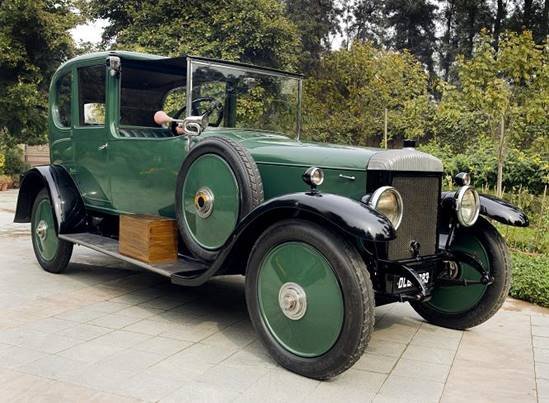
What started your car collection and what sort of models is it composed of?
Our family have one of the biggest collections of vintage cars in India. The first car we collected was a convertible Mercedes that was in a terrible condition and had cats living in it. It was only much later on that my husband discovered it was custom built. We acquired it for the lavish sum of 50,000 rupees – about £9,000 in today’s money. We also have some of the earliest vintage cars to be built, including Cadillacs from 1900 and 1902 and a Rover 1906, brought to Southern India by a British tea estate manager, and they’re all beautifully designed.
We now own 37 vintage cars that are kept in a garage in Delhi and we have a team of seven mechanics that work to restore them.
What, for you, is the best thing about cars from the pre-war period?
My husband and I love old cars, but our interest goes back much further to the pre-war years. We both adore vintage cars – defined as any car built before December 1939 – and we have been lucky enough to acquire a substantial collection since buying the first one in 1980. As for the best thing about these cars, I think it’s the simplicity of the engineering combined with the quality.
Another attraction for my husband is the challenge of restoring these cars to their original condition. It’s a real labour of love that can easily take 5-6 years, and sometimes more than 10. Mainly this is because it is far harder to find the original parts for a vintage car compared to a classic car. Sourcing these can require a significant amount of ingenuity, patience and often a dose of luck. Yet this makes it all the more satisfying.
What informs your buying approach – what do you look for in every car that you purchase?
Cars that will increase in value and popularity with time: our first vintage Rolls Royce cost $3000-$4000 and is now worth around $250,000.
This is not the reason we collect vintage cars though. For us, the pre-war period was the real hayday of the motor car and by collecting them we can help ensure it is not forgotten. Vintage cars have provided us with so much pleasure over the years and we intend to put the collection in a trust so that they can be enjoyed by generations to come. The cars are not on public display but one day we hope they will be. We plan to build a car museum that will sit alongside an art gallery exhibiting our collection of art, along with a hotel and convention centre. It will be designed as a place to mix business and pleasure.
What are some of the key models in the collection and the background behind them?
The stories behind the cars are often incredibly interesting. One notable car we have is a Bugatti, a 1921/1923 model that was originally imported to India by a family based in Bombay who manufactured umbrellas. They purchased it for their son but sadly he went blind and was not able to drive it. The car had been kept in a garage, but the roof had fallen in and the car was badly smashed. It has taken more than 10 years to restore the car and took three years simply to get permission to send the engine to the UK to get it re-built.
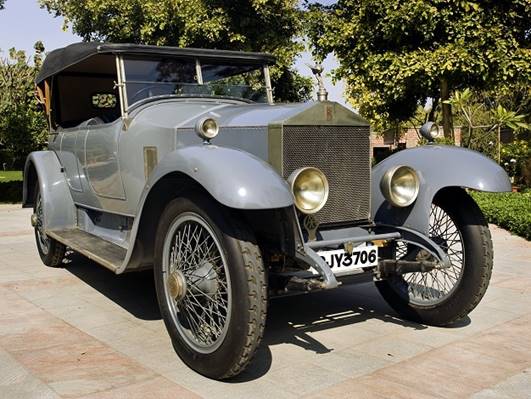
PHILANTHROPY
You have several different philanthropic strands – what would you say unites them all?
A desire to empower women is at the heart of what I do. Sport and Art are two great passions of mine, but women are still grossly under-represented in both. What unites my work in both sectors is a desire to change this, and ensure women have the exposure, support and funding that they deserve.
What can you tell us about your current philanthropic projects?
My philanthropic interests are not solely confined to art, and I have always been passionate about supporting and creating new projects that empower women and support disability causes in different ways. It is for this reason that I founded my own charity, Path to Success, in 2005. We have always supported disability causes, but in March 2018 we decided to focus more on women.
Our current campaign, Path to Tokyo 2020, launched on International Women’s Day in 2018 and has been extremely well received. We are empowering and supporting twelve disabled female athletes whose dream is to compete for Great Britain at the Paralympic Games but lack the necessary funding to compete. With Tokyo 2020 less than a year away, this is a very exciting time for the charity and there is a real chance of our athletes bringing home some gold medals.
How easy is it to generate interest and donations for women’s disability sport?
Women’s sport is slowly gaining more recognition, the women’s football world cup was evidence of that, but women’s disability sport still does not attract anywhere near the attention it both needs and deserves.
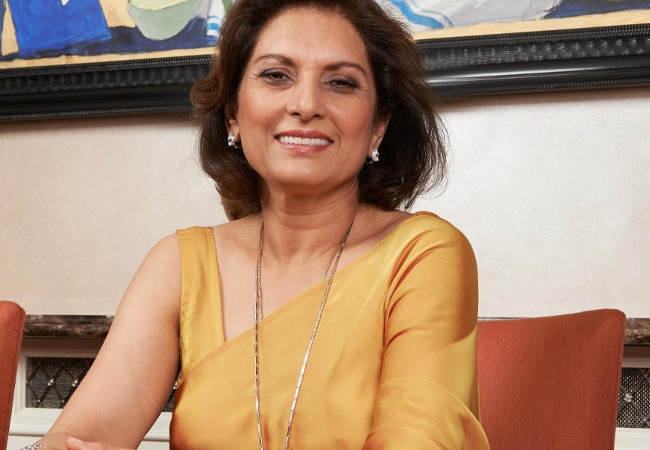
We run a number of initiatives throughout the year to try and change this. Two highlights are our fundraising gala and our annual corporate wheelchair basketball challenge at the Queen Elizabeth Olympic Park. Corporate teams pay a fee to enter and compete against each other. It is a fantastic opportunity for them to spend a day out of the office building relationships, trying a new sport, and playing alongside international-standard athletes, which is a rare and exciting thing.
Our upcoming fundraising gala is on October 3rd at the Historic Church House in Westminster. This is always a fantastic event, and a chance for supporters to enjoy a fun and entertaining evening, meet with the athletes they are supporting and trade stories on their life experiences. Building those networks is so important if women’s disability sport is going to continue to grow.
ART
Take us through your art collection? How is it organised and what does it cover?
Stellar International Art Foundation was established in 2008 and took its basis from our private art collection. The Collection has become internationally renowned for its content, coverage and activities around the globe. From London to India, Dubai to St Moritz, the material of the Collection and its efforts have earned it a distinguished place amongst the increasing number of foundations across the globe.
Currently the foundation comprises over 800 works dating from the late 19th Century to the present day, including international artists and ranging from sculptures to paintings.
Stellar has staged exhibitions of significant heretofore unseen works, has produced a seminal publication on a master artist within the Collection and has even been revered by some of the worlds’ most respected curators and critics. These are organised by our Managing Director and Art Advisor Anya Zakharova.
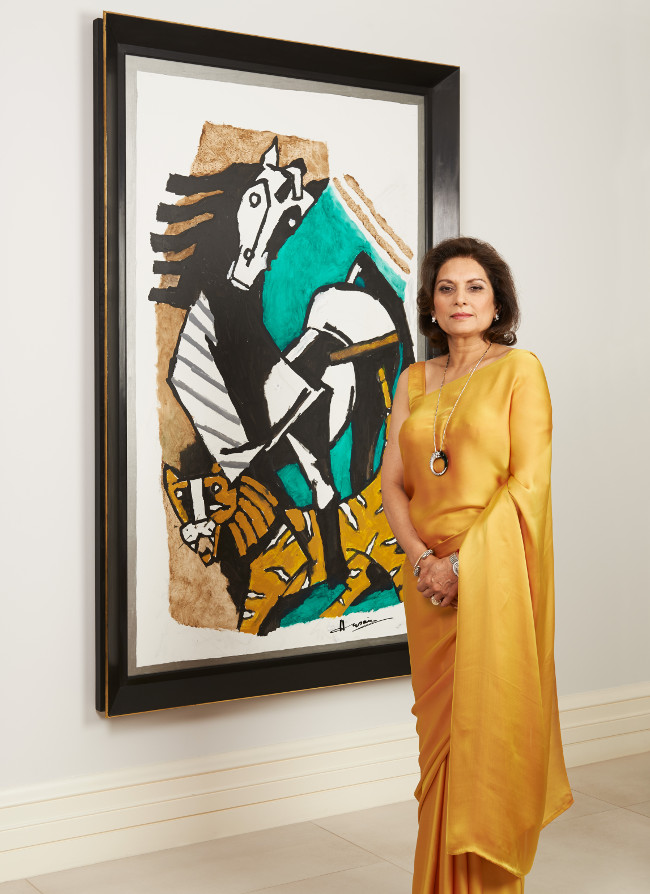
Could you describe the process that goes into arranging and procuring the works?
As we are a foundation, we have to create an annual budget and a well thought out plan for future acquisitions. In essence, this means finding a middle ground between what we could ideally love to have in the collection and the artistic attributes of the pieces we choose.
In terms of procuring the works, we tend to have a yearly curatorial theme suggested by our art advisor. This year, the theme is feminism and female artists. As such we have recently acquired new art by English feminist Tracey Emin entitled ‘The More of You the More I Love You”.
What are some of your favourite works in the collection? Why?
I’d say our collection of MF Husain’s works. We have one of the largest artworks outside the estate, making it the most significant home for the artist’s oeuvre. With over 250 works spanning from the early 1950s through to his final years, the Collection supersedes all the world’s gallery, museum, and private collections. A great patron of the artist, we were chosen as the guardians of not only a large volume of work in general, but especially his most famous and, arguably, most important series: Maria. With the same ethos in mind, the Foundation has sought to keep his most significant series intact for future generations.
Ten years after the founding of the Stellar Foundation, what are some of the things that you are proudest about?
For me the real meaning of the foundation lies not in its material possessions but the opportunities it provides for artists. By collecting Russian, European, American and Indian Art and distinguishing our selection less on regional concerns and more artistic talent, we have been able to champion excluded artists and give them a well-deserved voice. Seeing these artists thrive through our help has been incredibly rewarding.
Image credit at the very top of the article: Charles Shearn












